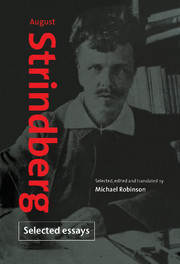Book contents
- Frontmatter
- Contents
- Notes on the text
- Introduction
- from Vivisections (1887)
- ‘On Modern Drama and Modern Theatre’ (1889)
- from Vivisections II (1894)
- ‘Césarine’ (1894)
- ‘Deranged Sensations’ (1894)
- ‘In the Cemetery’ (1896)
- from Jardin des Plantes (1896)
- ‘On the Action of Light in Photography’ (1896)
- ‘A Glance into Space’ (1896)
- ‘Edvard Munch's Exhibition’ (1896)
- ‘The Synthesis of Gold’ (1896)
- ‘Contemporary Gold-Making’ (1896)
- ‘The Sunflower’ (1896)
- ‘The Mysticism of World History’ (1903)
- ‘August Strindberg on Himself’ (1909)
- Notes and commentary
- Index
‘The Sunflower’ (1896)
Published online by Cambridge University Press: 18 December 2009
- Frontmatter
- Contents
- Notes on the text
- Introduction
- from Vivisections (1887)
- ‘On Modern Drama and Modern Theatre’ (1889)
- from Vivisections II (1894)
- ‘Césarine’ (1894)
- ‘Deranged Sensations’ (1894)
- ‘In the Cemetery’ (1896)
- from Jardin des Plantes (1896)
- ‘On the Action of Light in Photography’ (1896)
- ‘A Glance into Space’ (1896)
- ‘Edvard Munch's Exhibition’ (1896)
- ‘The Synthesis of Gold’ (1896)
- ‘Contemporary Gold-Making’ (1896)
- ‘The Sunflower’ (1896)
- ‘The Mysticism of World History’ (1903)
- ‘August Strindberg on Himself’ (1909)
- Notes and commentary
- Index
Summary
If you would know the invisible, look carefully at the visible
The TalmudTwenty years ago I read the Botanic Excursions of Elias Fries, Linnaeus' last pupil in Sweden. In one passage the author discusses the relative superiority of various flowers, and awards the prize to the sunflower for the following reasons. The sun, the omnipotent, the source of life, light and power, makes its influence directly felt throughout the plant kingdom. Plants, the daughters of the sun, adapt themselves to their mother, and strive to imitate her. None has succeeded better in this than the sunflower, which reproduces the image of the sun in its inner and ray-flowers, and which follows the sun's movements and completes its period of growth within a year, the time it takes the sun to traverse the twelve houses of the zodiac.
At that time people knew nothing of Swedenborg's ‘correspondences’, and Bernardin de Saint-Pierre's ‘harmonies’ had been forgotten. The mental ability to ‘see similarities everywhere’ was pardonable only in poets, those harmless makers of images, unpardonable in others who were called mentally deranged.
Fries' discovery was therefore dismissed as a very beautiful rhetorical figure, and things went on as they were.
It was last year that Bernardin de Saint-Pierre's posthumous works opened up the world of harmonies to me, and in the author of Paul et Virginie, otherwise an engineer in the national survey and the director of the Jardin des Plantes, I rediscovered Fries' idea, but more fully developed and more striking.
- Type
- Chapter
- Information
- August Strindberg: Selected Essays , pp. 178 - 180Publisher: Cambridge University PressPrint publication year: 1996



